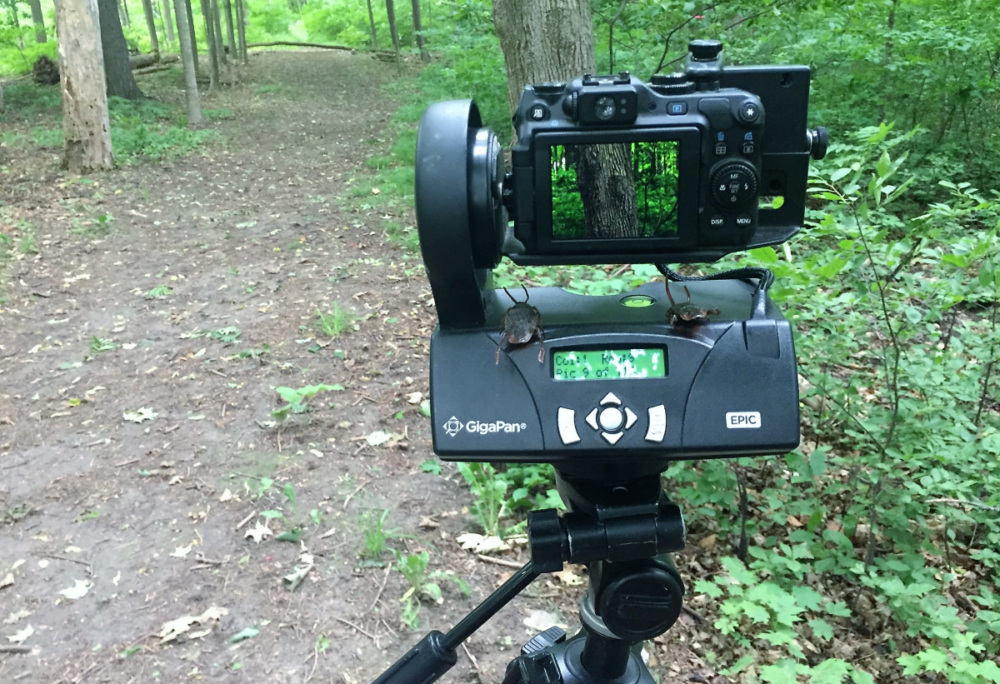
How do you bring a small forest in the middle of a city to students around the world? Two biology professors at the University of Guelph have created a Digital Forest for just such a purpose.
Profs. Shoshanah Jacobs and Alex Smith have long used GigaPan technology as a teaching tool in their popular Discovering Biodiversity (BIOL*1070) course. For the course, which is the largest in the Department of Integrative Biology, students study an ecologically diverse forest on the University campus called the Dairy Bush.
In response to COVID-19 restrictions, the pair had to change the way they deliver the course. But the pandemic has also motivated them to expand the tool to open the Dairy Bush to a more widespread community of learners.
Smith was an early adopter of the sophisticated panoramic photography technology, which was introduced in 2008 as part of a NASA mission. It was originally made to capture high-definition panoramas on Mars but now has an array of terrestrial applications where gigapixel images are needed.
“Each GigaPan image holds a vast amount of detailed information, and each one can be explored in fine detail,” said Smith.
In 2009, he began taking one weekly habitat panorama in U of G’s Dairy Bush.
“That’s 4,052 days, or 572 consecutive weeks, standing in the forest each time for two hours. That’s nearly 50 complete days in the forest with the GigaPan equipment.”
The Dairy Bush is a kind of living laboratory and spectacular classroom on campus. An 8.5-hectare natural hardwood forest of maple, beech and other towering trees – with winding trails, clearings and hills – it is visited each year by hundreds of students and instructors.
Jacobs said the COVID-19 pandemic has fundamentally changed the way students interact with the Dairy Bush. Before physical distancing measures restricted in-person classes on campus, students ventured into the forest on the northwest corner of campus and spent hours making detailed biodiversity observations.

Until now, GigaPan images were used in the classroom strictly for research purposes, she said. Now they are integral to Digital Forest, a virtual classroom that acts as a kind of stand-in for the real forest and its ecology.
“We are now working with GigaPan to make the user interface more accessible to more people, whether they are right next door or thousands of kilometres away,” Jacobs said. “In Discovering Biodiversity, we will use the GigaPan technology to develop a research case and students will collect their data and figure out the conclusions with the Digital Forest. Now, because we are spread out around the world, we are bringing the forest to each student.”
The Digital Forest will be used beyond the pandemic, becoming a permanent tool in the classroom.
It would not have been possible without Smith’s 11-year effort to capture the Dairy Bush in all its intricate detail, said Jacobs. Course coordinator Prof. Lisa Robertson has worked on the curriculum side of the course and its new virtual reality.
“She is taking our madness and transferring it into lessons that the students can build upon,” Jacobs said. “She’s a vital part of the team.”
Prof. Ryan Gregory, chair of the Department of Integrative Biology, said laboratory and field activities pose a particular challenge for remote teaching.
“But our instructors have more than risen to the challenge by coming up with innovative, exciting ideas like this one,” he said. “This particular example stands out for its ambitiousness and the sheer scale. I am thrilled to see professors Jacobs, Smith and Robertson create something so innovative for our students this semester.”
BIOL*1070, while a large course, emphasizes active learning and hands-on experience in the Dairy Bush.
“I think this is an excellent way of keeping students engaged and connected with our wonderful campus as we shift to remote instruction,” said Gregory. “The value of this new teaching tool extends far beyond getting through the challenges of the pandemic. I see huge potential to expand it to field sites and to students from all over the world. This idea is definitely a keeper.”
Contact:
Prof. Shoshanah Jacobs
www.shoshanahjacobs.ca
Prof. Alex Smith
salex@uoguelph.ca